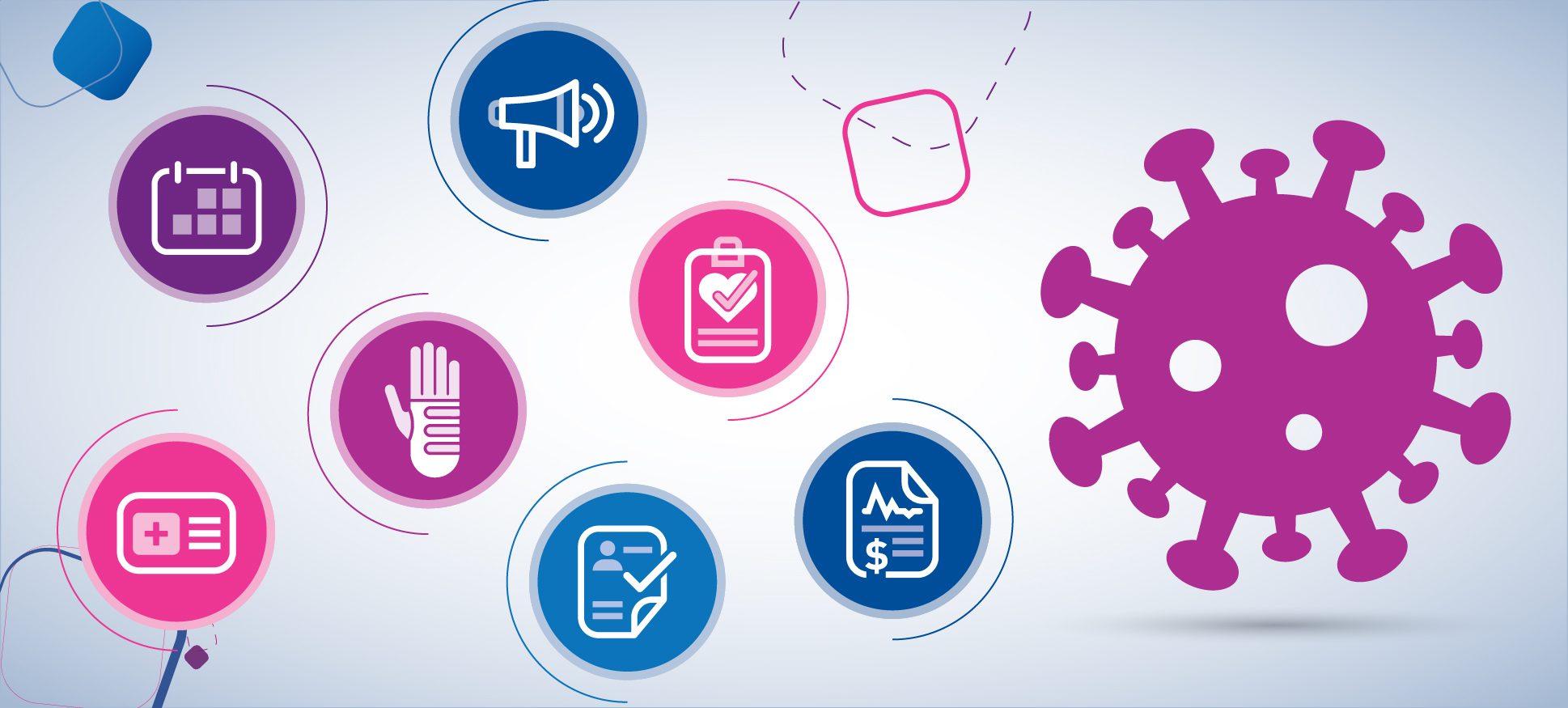Tag: patient experience

US hospitals have provided more than $702 billion in uncompensated care over the last two decades. To protect profits, healthcare organizations must be vigilant about finding any available insurance coverage for their patient’s care. But for many, recent regulatory changes and pandemic-related disruption have made navigating an already complex reimbursement landscape even more challenging. Checking for missing insurance coverage and chasing payments consumes staff time that could be better spent elsewhere. However, with the right revenue cycle management tools, healthcare organizations can reduce profit-eating write-offs and denied claims. Experian Health’s new white paper sets out an end-to-end strategy to help healthcare providers find missing and forgotten coverage. With a comprehensive game plan for minimizing lost revenue at every touchpoint in the patient journey, providers can optimize the patient experience, reduce revenue leaks, and ease the burden on staff. Here, we explore some of the trends that are challenging reimbursements, identify opportunities to find missing coverage quickly, and present best practices to eliminate the risk of bad debt at every stage of the patient journey. Trends that make revenue recovery tougher Healthcare providers must keep abreast of regulatory changes that affect the reimbursement process, which often challenges profitability. For example, the American Rescue Plan Act of 2021 made some key changes to the Affordable Care Act. This included expanding Medicaid provision, decreasing Medicare premiums, and accelerating the COVID-19 vaccination program. For providers, this means an influx of patients who are newly entitled to government assistance, requiring new processes to avoid delayed claims and payments and recover Medicare debt. Many of these measures are a response to the pandemic. COVID-19 has squeezed household finances, leaving some patients without jobs and access to health insurance. Although employment rates are showing signs of recovery, tracking coverage as patients start new jobs remains highly resource-intensive for collections teams. Chasing self-pay revenue can often be more expensive than writing off the initial bill. The growing focus on price transparency may mitigate some of these challenges. Proactive patient engagement can help patients understand and plan for their bills while improving the overall patient experience. The No Surprises Act, effective January 1, 2022, aims to protect patients from unexpected bills for out-of-network care in emergency and non-emergency settings. The regulation protects patients but creates significant work for providers to modify existing processes and systems in order to meet compliance standards. Dustin Whittier, Senior Director of Product Management at Experian Health, explains that automating early coverage checks can be an efficient way to help consumers manage their changing healthcare obligations. He says, “With the increase in high deductible plans, the urgency surrounding COVID-19, regulations such as the No Surprise Act and Notice of Care, and a strategic focus on patient satisfaction and transparency, the impetus to automate knowing the full scope of insurance coverage – as close to the point of care as possible – has never been greater.” In 2021, Coverage Discovery tracked down previously unknown billable insurance coverage in more than 27.5% of self-pay accounts. The Experian Health team can help healthcare organizations keep on top of changing regulatory requirements and implement solutions that ensure compliance, improve the patient experience, and protect against uncompensated care. Optimizing for revenue recovery at every step of the patient journey Successful revenue recovery starts with a patient engagement strategy that simplifies the steps to reimbursement at every patient touchpoint. A three-pronged approach can increase the likelihood of payment by identifying the opportunities to check for coverage before the patient comes in for care, at the time of service, as well as aftercare. 1. Pre-service insurance coverage checks Verifying and tracking the patient’s insurance status before they come in for care means their financial obligations will be clear from the start. Advance knowledge makes it much easier for patients to plan – and pay – their medical bills. An automated coverage identification solution such as Coverage Discovery can scan patient information as soon as they schedule an appointment to find any previously unknown coverage, using multiple proprietary databases and historical information. 2. Identifying coverage at the point of care When the patient receives their treatment, Coverage Discovery can check for any billable commercial and government coverage that may have been missed during pre-service. Providers should also give patients opportunities to pay for care at this point too, to avoid the need to chase for payments later. A simple and quick payment experience can reduce the risk of additional A/R days and collections agency fees. 3. Post-service checks for unidentified coverage Finally, for any accounts that haven’t been settled at the point of care, providers should run further coverage checks before determining whether to send statements and payment reminders to the patient, to write the amount off as bad debt, or to engage a collections agency. Coverage Discovery can detect any discrepancies that could lead to denied claims. It also offers weighted confidence scores so that accounts are reclassified and rebilled appropriately. Automated scrubbing can eliminate manual processes so staff can use their time more efficiently. These steps will help plug revenue leaks at every stage of the patient journey. Not only will that improve cash flow and reduce the risk of bad debt, but it also helps create a more satisfying patient experience. Learn more about how Coverage Discovery helps recover revenue throughout the patient journey and gives patients peace of mind.

As patient expectations shift, providers that offer a personalized healthcare marketing experience will be more likely to attract and retain satisfied consumers. The pandemic accelerated this shift. As a result, the traditional ways of healthcare marketing are starting to fall short. For example: A healthcare marketing strategy that’s designed for an “average consumer” results in a one-size-fits-all model that doesn’t always meet a patient’s individual needs. Communication options with fixed hours and channels don’t reflect “patient first.” Outreach messages blasted to an entire patient email list miss the mark for individuals who don’t speak the language or might prefer a quick text message instead. A study by Dassault Systèmes and CITE Research found that 83% of consumers expect products and services to be personalized within moments or hours. They’re accustomed to the “one-click” digital retail experience, which offers instant access to relevant recommendations and flexibility about how and when to buy. They’re also suffering from information overload, thanks to the sheer volume of emails, messages, articles and videos flooding their digital devices. Personalized communications can remedy that and help consumers feel respected and empowered, which drives connection and loyalty. But personalization isn’t just important for patient outreach. Personalized healthcare marketing can also help ensure patients get the treatment they need, by anticipating individual needs and highlighting relevant services at the right time. With the COVID-19 pandemic continuing to influence access to care, personalized healthcare communications can also be tailored for different patient segments. This can help reassure or remind individuals to book vaccination appointments or reschedule deferred care. Improve patient engagement with personalized outreach As digital offerings grow, consumer engagement expectations evolve. Providers must keep pace and communicate accordingly. Incorporating information about patients’ lifestyles, behaviors and preferences enables providers to deliver the right message at the right time. It also helps providers select and use the most effective channel of communication. Patients are more likely to respond and are empowered to manage their healthcare journey. For example, a Gen Z patient may prefer to receive appointment reminders by text, while an older patient may prefer a physical letter. One patient may prefer to get prescriptions mailed to their home while they’re at work, while another may be content to visit a pharmacy and pick up their medication while shopping nearby. Some patients will want a text message with a payment link to clear outstanding bills immediately, while others will appreciate a customized payment plan. Experian Health’s State of Patient Access survey 2.0 found that patients welcome proactive outreach by providers, though many say this doesn’t happen. Providers recognize the value in proactive patient engagement, but many say they lack the data to reach out effectively. With reliable consumer data and analytics, providers can create holistic profiles and deliver improved marketing to better serve new and existing patients. ConsumerViewSM pools data points on core demographics, behavioral insights, psychographic information and financial data to help providers understand their patients. This data can then be analyzed using Mosaic® USA and TrueTouchSM to segment, identify and reach the target audience with the most relevant message and format, and adapt based on consumer response. ConsumerView also adheres to consumer data privacy regulations, so providers can actively engage patients and build patient loyalty while confident in the knowledge that they have permission to use the data. Reduce readmissions and improve patient outcomes with better segmentation Personalized healthcare marketing isn’t just about messaging and channels. Providers that have a holistic picture of a patient’s lifestyle, life events, geographic changes and socio-economic challenges will be in a stronger position to anticipate their evolving wants and needs. For example, social determinants of health (SDOH) data can tell providers which patients may need extra assistance when visiting a doctor’s office, so that appropriate measures can be put in place. They might help identify patients with potential comorbidities that warrant proactive reminders about preventive check-ups. Similarly, providers can segment patients according to their financial situation. This can help with creating custom payment plans and sending timely payment reminders through targeted communications channels. Effective post-admission engagement can also help patients access the support needed to adhere to care plans, thus minimizing the risk of readmission and reducing unnecessary costs. A McKinsey & Co study found that around a third of patients with unplanned, high-cost follow-up care reported reasons that were considered avoidable, such as receiving unclear post-discharge instructions. Boost retention and recruitment with patient-centric and personalized healthcare marketing As rising medical costs and pandemic-related lifestyle shifts prompt more patients to shop around for care, providers must take action to create a healthcare experience that’s truly patient-centric. With data-driven healthcare marketing tools, providers can differentiate their services from other health systems vying for the same market. Find out how Experian Health can help your organization use consumer insights to build a patient-focused, personalized health marketing strategy to attract and retain satisfied consumers.

The recent discovery of the Omicron variant has placed the world on high alert. As COVID-19 continues to transform and evolve, erupting as “new” pandemics within the existing pandemic, it is becoming clear that digitally-enabled clinical care and access to that care are some of the world’s tools to mitigate its spread. Should infection rates rise, providers can anticipate fluctuations in patient volumes, which may trigger a return to the scheduling complexities seen earlier in the pandemic. Streamlining patient access with digital scheduling to minimize wait times, free up hospital beds, and ensure efficient intake workflows is going to be crucial. New variants could also exacerbate existing healthcare staffing shortages, which is a major concern for providers whose capacity is already at a “tipping point.” With a winter flu season “twindemic” looming on the horizon, and more people traveling over the holidays, this challenge may only get tougher. One route through this uncertainty is to continue the digital pivot seen in the early days of the pandemic. Here, we look at how flexible self-scheduling tools and other digital services can continue to help providers maintain operational efficiency as they navigate the implications of this new coronavirus strain. Uncertainty about Omicron – and future variants – could trigger patient scheduling complexities The new variant could trigger a rise in patient numbers, as seen with the Delta variant. In parallel, some providers and states may follow New York’s lead to try to manage non-urgent care and postpone certain elective treatments. Patients, too, may decide to hold off on booking appointments if they’re worried about contracting the virus while visiting their doctor. This means that the scheduling (and rescheduling) challenges seen throughout the pandemic could resurface. Providers should be ready to offer easy and convenient self-scheduling options. Digital patient scheduling platforms allow patients to book essential care and reschedule deferred appointments from the comfort of their own home, using whatever channel suits them best. Not only will this ease pressure on busy staff and reduce the number of people sitting side-by-side in doctors’ waiting rooms, but it’s also a quicker and more reliable way for patients to plan their care. Providers can augment these operational efficiencies with digital scheduling and registration tools. Registration Accelerator can reduce the burden on patient access teams by allowing patients to create user profiles and fill out pre-treatment information from home. Double down on convenient vaccination scheduling New variant outbreaks also add a layer of urgency and complexity to the ongoing vaccination program. Boosting the country’s vaccination rates is a crucial defense against existing strains of COVID-19. Patient-friendly digital scheduling tools can make it as easy as possible for people to arrange an appointment, thus helping to bump up vaccination rates. Of course, if more people are encouraged to seek vaccinations and boosters, the scheduling process could get even more complicated. Again, digital self-scheduling tools can ease the pressure, by using real-time databases and automation to ensure that patients book appointments within the requisite vaccination window. Automation can also be used to deliver personalized patient outreach reminders, nudging patients to schedule their vaccine appointment if they haven’t made one already. Comprehensive consumer data can help identify the most appropriate messages and channels for different patients, to make it as easy as possible for them to plan and book their appointment. The federal response to new outbreaks has included provisions for vaccine outreach campaigns and education initiatives. Providers should consider how their own outreach campaigns are performing, as well as ensure that their scheduling platforms are ready to meet the increase in demand that’s likely to follow. Automation and digital scheduling tools could help alleviate staffing shortages Behind the scenes, providers are still wrangling with ongoing staffing shortages. According to an analysis of US Bureau of Labor Statistics data, hospital employment declined by nearly 100,000 between February 2020 and September 2021, amounting to a financial cost of around $24 billion. New variants could make this worse. If more staff are infected, healthcare organizations may find it more difficult to handle the increase in patient volume. Automating manual tasks can free up capacity by helping to manage the growing demand for services and reduce call volumes. These automated tools and systems are designed to be user-friendly for busy staff, and for patients looking for a stress-free patient access experience. With streamlined self-scheduling options and more efficient staff workflows, providers can feel more prepared in the face of uncertainty. Contact Experian Health to find out more about how digital scheduling tools can help your organization prepare as the Omicron situation unfolds.

As the digital healthcare revolution takes hold, do assumptions about a generation gap still hold true? Do Millennials and Gen Z have different expectations of healthcare providers compared to Baby Boomers and Gen X? In today’s hyper-connected world, the differences are a matter of degree. We’re all Gen C now. Futurist Brian Solis coined the term “Gen C” in 2012 to describe the rise of the “connected consumer,” a generation of active participants in the digital-first economy. Recently, the term has come to be associated with everyone living through the age of COVID-19. This includes pandemic babies whose early months have been shaped by quarantines and virtual playdates, and consumers of all ages who have reimagined their lives through digital tools and services. Gen C transcends the usual generational divides. Experian Health’s State of Patient Access 2.0 survey shows that patients of all ages embraced self-service technology and virtual care during the pandemic. Younger groups may be in the majority, but demand for a consumer-centric digital patient experience crosses demographic lines. Forget Millennials and Gen Z – it’s Generation COVID that’s driving the healthcare revolution. In this article, we look at what healthcare providers need to know about the attitudes and expectations of Gen C consumers. How does healthcare need to adapt to successfully engage the connected generation? Gen C: it’s an attitude, not an age Think With Google describes Gen C as a “powerful new force in consumer culture… people who care deeply about creation, curation, connection, and community. It's not an age group; it's an attitude and mindset defined by key characteristics.” Understanding the Gen C mindset will give providers the competitive edge when it comes to patient engagement. What might that look like? Gen C is constantly connected. Nearly nine in ten have a social media profile, with two-thirds updating it daily. They’re accustomed to organizing their life through apps and digital technology. Younger Millennials and Gen Z have grown up with the digital world in the palm of their hand, and have come to expect quick, flexible, and convenient app-like access to real-life services. Gen C values authenticity and transparency. Recent political, economic, and environmental turbulence has created a group of consumers who choose brands and services according to their personal values. There is also a greater emphasis on convenience and price. Instant access to information means they may be more likely to question healthcare advice and compare services. And news reports of data breaches and corporate scandals mean providers may need to work harder to gain their trust. Gen C chooses brands that embrace the power of personalization and community. Gen C expects personalized patient experiences. However, they’re also looking for community. Health and wellness brands that facilitated connection through online groups grew in popularity during the pandemic, especially when people were unable to work out together. As influencer culture continues to evolve, more brands are inviting real consumers to act as brand advocates. This includes utilizing social media to give consumers an opportunity to engage directly in product development. Healthcare services that can offer ways for consumers to connect with like-minded communities will be particularly attractive to Gen C. How does Gen C feel about health? It’s no surprise that the pandemic has made consumers more health-conscious. Gen C takes a more holistic view of health than previous generations and is more likely to use wearables and fitness apps to track their health goals. They’re also more comfortable talking about previously taboo topics, such as mental health or sexual wellness. Digitally fluent consumers are also more comfortable seeking answers to health questions online. A study by Gartner found that 41% of consumers with a health issue would talk to friends or family, and 38% would search for information on their own, before contacting a physician. There’s an opportunity for providers to position themselves as the first and best resource for reliable, engaging and accessible health information. As Gen C’s influence grows, it pays for providers to invest in understanding their needs and expectations. How should providers adapt the healthcare experience for Gen C? Offer convenient, flexible and self-service access to care Flexibility, speed and convenience are woven into Gen C’s expectations of the healthcare experience. The State of Patient Access 2.0 survey found that around seven in ten consumers said they wanted to be able to schedule their own appointments online, and a similar number wanted the option to contact their provider through a patient portal. Gen C is less likely to use a desktop computer or make a phone call, so enabling mobile-friendly apps is key. Online self-scheduling allows patients to find and book available appointments using their mobile devices. Integrations with scheduling rules and up-to-the-minute calendar checks mean patients are only shown the most relevant provider booking information. It’s a closer match to their other consumer experiences, as opposed to long phone calls and wait times with a call center representative. Similarly, automated registration tools can simplify patient intake and give consumers the option to check their details on their mobile devices. Rather than filling out multiple paper forms that are labor-intensive and error-prone, patients can simply complete the process on their phone or tablet. And for the 39% of patients who worry they’ll catch an infection at their doctor’s office, being able to complete intake tasks without sharing clipboards and pens in the waiting room will be a huge relief. In a recent podcast interview with Beckers Hospital Review, Jason Considine, Chief Business Development Officer with Experian Health, said: “With COVID-19, digital tools and data-driven solutions introduced more streamlined processes into our healthcare system. The expectation is that they’ll remain. Providers must embrace this digital transformation. Invite patients to self-schedule online, leverage digital outreach tools, simplify the registration process, and provide a transparent cost of care with flexible payment options… We need to create a simple consumer experience that matches what patients have in other facets of their lives.” Use consumer data to offer personalized outreach and boost patient loyalty Understanding Gen C requires providers to rethink patient loyalty. In the past, patients might choose a physician and stick with them for much of their adult life. Now, they’re more likely to shop around. Research published just before the pandemic showed that 73% of consumers expect companies to understand their needs and expectations, and 62% expect those companies to adapt according to the consumer’s actions. Experian Health’s survey also showed that patients welcome proactive outreach by providers, though many providers fail to do so. Nearly half of providers said that inaccurate or incomplete data prevented this. Providers know that a personalized healthcare experience is good for their bottom line, but without reliable data about each patient’s needs, preferences, and lifestyle, delivering this is a challenge. Consumer healthcare marketing data can pull together reliable data sources to allow providers to communicate the right message in the right channel for different patient segments. For an even richer view of patients’ individual non-clinical needs, providers should consider including social determinants of health (SDOH) data. COVID-19 revealed gaps in healthcare providers’ capacity to leverage data to support economically and socially vulnerable groups. With this type of data, providers can personalize their outreach strategies in a way that truly supports individual patients and underserved communities. Make it easy to pay with upfront estimates, coverage clarity, and digital payment methods Household financial concerns were felt even more acutely over the last two years. Younger generations say they’re more likely to consider cost when it comes to making healthcare decisions, with almost 60% saying it’s now the main consideration. Gen C expects upfront, transparent cost estimates, with two-thirds of younger consumers saying they’re more likely to seek out medical care if they know the cost beforehand. The State of Patient Access 2.0 survey confirms that price transparency remains high on the list of patient demands. To this end, there has been a major regulatory push toward price transparency at the federal and state levels. Many providers are deploying transparent pricing strategies and payment estimate tools to make it easier for patients to navigate the costs of care. Demonstrating a commitment to price transparency can be a powerful marketing strategy to attract and retain loyal consumers – especially for those who are most affected by fluctuating employment and financial circumstances. Watch our interview with Dan Wiens, Product Director for Patient Estimates at Experian Health, in which he describes how price transparency and patient estimates will evolve in 2022. Patient payment estimates give patients clear, accessible, and easy-to-understand estimates before they come in for care. A cost breakdown is delivered straight to their mobile device, with the option to pay right away. In addition to payment estimates, Gen C is looking for payment plans and payment mechanisms to be available at their fingertips, anytime, anywhere. In a world where they can order food and pay household bills at the tap of a button, it can be frustrating to have to wait a month for a medical bill. In fact, 70% of consumers say healthcare is the industry that makes it hardest to pay. Providers that can offer a choice of simple payment methods, pre-and post-service, will be likely to attract more Gen C patients. An integrated solution such as Patient Financial Advisor can help these tech-savvy consumers see their estimated cost of care, and make payments right from their mobile device. For providers, the benefits of making it easier for patients to pay are clear. As demand for transparent and contactless payment methods continues to grow, investing in these digital innovations could be an effective route to recouping some of the financial shortfall experienced during the pandemic. Don’t forget – more healthcare staff are Gen C, too Digital transformation isn’t just a consumer issue. Many of the digital tools and services that enable providers to meet the needs of connected consumers will offer benefits at the organizational level too. Automation and advanced analytics lead to more efficient processes, better use of staff resources, fewer errors and more meaningful workflow insights. Time and money are saved, profits increase and staff enjoy a more satisfying working experience. Investing in incremental innovations on back-end systems is even more relevant, given that growing numbers of healthcare staff are Gen C themselves. Just like consumers, they are accustomed to using digital apps and tools to run their lives, and they’re looking for similar efficiencies while at work. Failure to provide staff with the tools they need to do their jobs in the digital age could lead to wasted time, revenue loss, and the adoption of less reliable and secure workarounds. With the right digital tools and systems, providers can equip staff to fulfill their roles safely and effectively -- attracting and retaining a high-performing workforce. Providers must open their digital front door to secure patient loyalty now and in the future The pandemic has cemented a cultural and practical shift in the way healthcare is delivered. Now that more patients have had a taste of a digital patient experience, they expect it to continue. Gen C is pushing the healthcare industry to catch up to convenient, connected, consumer-centric services that are the norm elsewhere. Providers that can engage with Gen C in their digital language now will attract more satisfied consumers over the long term. Contact us to find out how we can support your organization bring together all the digital tools at your disposal, to create a healthcare experience that’s in line with Gen C’s evolving expectations.

Being able to settle bills anytime, anywhere, is one of the reasons why 110 million Americans switched to “digital-first” payment methods last year. Today’s consumers can pay household bills with their mobile devices while cooking dinner or waiting in the school pick-up line. They can pay for their morning coffee by tapping their phone at the point of sale. Imagine their frustration when paying for healthcare still involves paper bills, multiple phone calls, and limited payment options. But the healthcare industry can make the same “anytime, anywhere” payment promise. Berenice Navarrete, Director of Product Management for Patient Payments at Experian Health, says: “We’ve seen healthcare make great strides in using automation and digital tools for scheduling, registration, and telehealth, fueled in no small part by the pandemic. As consumer payments are constantly evolving, there are huge opportunities for improvements in the patient payment experience too.” “We’ve seen healthcare make great strides in using automation and digital tools for scheduling, registration, and telehealth, fueled in no small part by the pandemic. As consumer payments are constantly evolving, there are huge opportunities for improvements in the patient payment experience too.” -Berenice Navarrete, Director of Product Management for Patient Payments Experian Health’s recent Payments Predictions white paper identifies seven emerging healthcare payment predictions and trends heading into 2022. This blog offers a preview of the top three insights that will be of interest to providers intending to leverage – or considering – digital tools that simplify payments and speed up healthcare collections. Prediction: Patients want fast, secure and smooth payments to match their experience in other industries. According to Experian Health’s State of Patient Access 2.0 survey, providers are feeling more confident about collecting payments from patients now, compared to a year ago. However, the collections landscape is always changing; providers should continue to find ways to match consumer expectations with tailored communications, flexible payment options and automated payment methods. Listen in as Matt Baltzer, Senior Director of Product Management at Experian Health, explains why providers feel more confident about patient collections. He also discusses how automated healthcare solutions can help providers shore up these gains and optimize healthcare collections – especially as consumer behavior returns to pre-pandemic patterns. As cash usage declines, patients are looking for a wider variety of payment options – a trend that’s likely to gather steam as digital payment platforms like Apple Pay and Google Pay continue to gain traction. Providers must keep pace with these advances in consumer payment technology. Utilizing Patient Financial Advisor is one way to give patients the flexible experience they want. This solution sends personalized text messages with links to convenient and contactless ways to pay. Patients may have different preferences about payment methods, but they all want to feel confident that their payment is secure. With PaymentSafe, healthcare providers can collect any form of payment securely and quickly, regardless of the payment option a patient chooses. Prediction: Patient loyalty will be tied to a convenient and compassionate payment experience. A poor payment experience will leave a bad taste in the patient’s mouth, regardless of how good the rest of their healthcare journey has been. With 70% of consumers saying healthcare is the industry that makes it hardest to pay, any provider that offers a smooth, supportive and transparent payment experience is going to stand out from the competition and foster greater patient loyalty. Comprehensive consumer data can give providers early and accurate insights into a patient’s specific financial situation. This information can help providers direct the patient to the most appropriate financing options. Automation can then be leveraged to send timely reminders of open balances, improve patient engagement and minimize the risk of missed payments. Tools such as Patient Financial Advisor and Patient Payment Estimates can help providers give patients transparency, control and reassurance from the very start of their financial journey, so bills are settled quickly and easily. Prediction: Automation will be used for an increasing number of payment-related tasks. Artificial intelligence and automation aren’t just for cars and the metaverse. Technological advancements are opening up a wide range of benefits to healthcare providers, from faster patient payments to fraud prevention. Automation also enables operational efficiencies in reporting and reconciliation, while protecting and processing unprecedented amounts of patient data. For example, Collections Optimization Manager uses extensive datasets and advanced analytics to segment patient accounts according to each individual’s specific financial situation. Patient satisfaction will improve because patients receive the right support at the right time. Additionally, providers will be able to use monitoring and benchmarking data to spot previously unseen opportunities and further improve collections. Keeping that “anytime, anywhere” promise COVID-19 was a catalyst for the evolution of healthcare payments. Digital payment solutions that give patients easy, convenient, and safe ways to pay not only help meet changing consumer expectations but will also allow providers to boost loyalty and revenue for years to come. Download the white paper to discover a full list of healthcare payment predictions and find out how to create a modern payment experience that meets patient expectations.

COVID-19 transformed the patient journey, and it's clear when we evaluate every step. Data and technology gave patients the convenience, flexibility, and control to get care on their terms, and these changes will be here to stay. From marketing to scheduling to payments and more - providers and payers have ample opportunities to respond to these changes and will need to adapt their future strategies accordingly. Self-scheduling, mobile registrations, and automated authorizations are a few examples of tools and technologies that are more than likely to remain prominent in healthcare. What other changes are here to stay? In this new infographic, we take a dive into each of the 7 steps to see how data and technology has impacted the patient journey, and provide strategic recommendations on how providers and payers can adjust post-pandemic: The use of data and digital tools opened up new doors for greater patient access, engagement, transparency, and control. The post-COVID-19 patient journey is going to continue to evolve - payers and providers will need to adapt to keep up with the changes, to ensure that patients experience the best outcomes. To get a deep dive into all of the changes to the patient journey, download our white paper.

This is the third in a series of blog posts highlighting how the patient journey has evolved since the onset of COVID-19. Explore how digital patient intake solutions are transforming the registration process - presenting patients with self-service options and providers with an automated and more efficient process. To read the full white paper, download it here. Registration is a familiar pain point in the patient journey, but COVID-19 has pushed both patients and providers to embrace digital patient intake processes and solutions. These new solutions move registration out of the waiting room, reduce errors and inefficiencies, automate billing, payments and create an enterprise-wide approach to data. Digital patient registration, once considered a “nice to have,” is now a widespread priority. A reveals that 88% of providers plan to invest in patient intake capabilities as a result of the pandemic, up 15% over a year ago. Patients lead the way on post-pandemic digital experiences COVID-19 marked a tipping point in the digital patient experience. Contactless care in the form of telehealth, along with increased use of patient portals and self-service scheduling tools, helped patients access care from a distance. Now, even though 81% of patients say they believe their provider has made on-site facilities safe, many still prefer online and mobile registration options. The study also revealed that 64% of patients prefer an online or mobile-enabled registration experience. “There’s an ‘ick’ factor,” explains Spiro Kalapodis, Director of Product Management for Registration Accelerator and Patient Financial Advisor at Experian Health. Patients actively dislike filling out paper forms, using registration kiosks and handling iPads set out for public use. “I don’t blame them,” says Kalapodis. “Even though the initial wave of COVID-19 restrictions has passed, I would prefer completing the registration process from the comfort of my car, rather than fill out forms in a crowded waiting room.” Simplifying a difficult process with digital registration and digital patient intake solutions One reason automated registration can be such a relief is that manual processes are notoriously difficult for providers to manage. Manual patient registration has always been labor-intensive and subject to human error; COVID-19 magnified these limitations. Paper forms are inefficient – they require design, printing, paper, clipboards, pens, secure storage and disposal. So many things can go wrong: receiving illegible responses, inputting data incorrectly, misplacing forms, the list goes on—and each step consumes valuable staff hours, with questionable results. Meanwhile, patients moved, visited new providers, changed jobs and switched insurance companies which meant there was more information needing capture. At the same time, providers are struggling to recoup revenue that was lost when patients deferred care during the pandemic. Optimizing both human and digital resources is key to delivering on an improved patient experience and regaining consistent profitability. “Patient intake solutions automate everything so data can be used consistently across the patient journey,” says Kalapodis. “For example, when a patient scans their insurance card and submits it through Experian Health’s Registration Accelerator, we leverage technology behind the scenes that can automatically indicate the patient’s insurance provider, policy details, and correctly return the patient’s subscriber details —information that staff members otherwise have to figure out for themselves. By automating this process, we’re saving time and resources, reducing misunderstandings and preventing data entry errors, which can be costly for providers and confusing for patients.” With the right data, providers can also create accurate estimates and even invite patients to pay their bills as part of the registration process. The patient receives a text message with a link to their estimate, along with the opportunity to pay online or on their mobile device. “Not only does this streamline the billing and collection process for providers, it creates a frictionless experience and increases greater transparency for the patient,” says Kalapodis. Getting to a single view of the patient Maintaining accurate data records can help providers deliver smooth patient experiences, better care, simpler payment processes and allows for better communication. Unfortunately, COVID-19 created another challenge on this front. During the pandemic, many patients signed into patient portals to schedule vaccine appointments. In their hurry to secure a shot, many inadvertently created duplicate accounts—and now have duplicate records. Obviously, multiple vaccine logins are not the only source of duplicate, inaccurate and incomplete patient data. But thanks to COVID-19, providers have this additional problem to contend with. Automation can make fast work of data issues. A universal identity manager creates a single view of the patient using unique patient identifiers, which prevent duplicate data records. The result: fewer billing errors and reduced associated costs, better care and a more frictionless patient experience. Patient intake can be painless Digital patient registration was a good idea even before COVID-19. Paper forms, entry errors, fragmented data, duplicate records, slow billing, and a lack of transparency made the registration process costly and inefficient. But COVID-19 made the need for digital more acute. Providers that hope to re-engage patients and recover profitability in the post-COVID-19 era need the power of data and automation. Learn more about how Experian Health can help you deliver a patient registration experience that fits post-pandemic expectations while improving efficiency, reducing errors and leveraging patient data. Download the white paper to learn how digital patient intake solutions are revolutionizing healthcare. Missed the other blogs in the series? Check them out: 4 data driven healthcare marketing strategies to re-engage patients after COVID-19 How 24/7 self-scheduling can improve the post-pandemic patient experience

The delta variant is still surging – and flu season is about to begin. How can healthcare providers leverage innovative technologies to streamline care and prepare for a potential “twindemic?” The summer of 2021 has not been kind to healthcare professionals. After a brief period of hope that the worst of the COVID-19 epidemic was over, the delta variant started its march across America, flooding hospitals and physician practices with a new wave of seriously ill patients. Autumn and winter look like they might be trouble, too, as delta joins forces with the seasonal flu to form a potential “twindemic.” After a mild season in 2020, many experts are predicting that the flu will reemerge with a vengeance this year as people return to in-person work and school. The combination of the two illnesses could easily overwhelm providers who aren’t prepared with technologies and workflows that allow them to serve patients efficiently and remain responsive to fluctuating demands. As providers look to navigate the coming months, they will need to make sure that they have self-service tools in place to keep patients safe and relieve strain on staff. With a few key digital solutions, resources can be maximized, unpredictable patient volume can be managed effectively, and difficult circumstances won’t slow down operations. Online self-scheduling can improve experiences for patients and staff Online self-scheduling is in high demand because it provides flexibility. patients want to move on with their busy lives without having to sit on hold with a representative. In Experian Health’s recent survey, the State of Patient Access 2.0, more than seven out of ten patients wanted to take the appointment-making process into their own hands, citing the speed and convenience of choosing their own appointments. Providers and physician groups appear eager to oblige. More than 70 percent of providers responding to the survey stated they are planning to offer online appointment tools to improve experiences and manage complex operations as the pandemic continues. The benefits for providers are significant. Online self-scheduling can measurably reduce administrative burdens on staff, allowing practices to reallocate their people power to other high-priority tasks. Giving patients the tools to make appointments may also help to reduce patient no-show rates, which can drain billions of dollars each year from provider organizations. Using self-scheduling tools, patients with transportation issues or concerns about exposure risks may be able to opt for telehealth visits, as opposed to unplanned visits to urgent care centers or the emergency department. This can help protect other consumers and staff from illness while allowing them to manage their own calendars. Mobile patient registration keeps patients safe from exposure during a "twindemic" Shifting patient registration from the clinic to the home can also be beneficial for patients and providers. When patients fill out new forms or update existing information in person, they increase their exposure risk by staying in the waiting room longer than necessary. In contrast, a digital registration accelerator solution offers a quick, touchless, and convenient intake experience on the patient’s own mobile phone. Patients can complete the process in their homes (where they are more likely to have all their personal information at hand), or in the parking lot while waiting for clearance to enter the building. On the provider’s side, automating patient intake improves operational efficiency and avoids errors that come from illegible handwriting and verbal information communicated through masks and plexiglass. Data integrity algorithms and real-time feedback for patients can correct mistakes quickly to ensure high accuracy of patient data – a crucial competency for treatment and reimbursement. Patient portals boost convenience, communication, and security As providers prepare to battle two illnesses instead of just one, practices shouldn’t forget to leverage one of the most important parts of the digital arsenal: the patient portal. Portals are instrumental for staying connected with patients, particularly with the 40% of patients who skipped medical care in the early months of the pandemic. As a complement to necessary in-person care, patient portals offer a convenient way to communicate with providers, complete administrative tasks, and access personal health information at their leisure. Providers must be certain, however, that their portals don’t become avenues for medical identity theft. Healthcare organizations must maintain tight security policies that simultaneously deliver an optimized patient experience. A patient identify-proofing and authentication solution that automates patient portal enrollment while adhering to the high standards of HIPAA and other industry requirements is key. Solid security can reassure patients that sharing digital health information with their trusted providers is safe - fostering more open relationships and leading to better care. Hopefully, fears of a “twindemic” will fizzle as communities continue to take sensible precautions against the spread of COVID-19. However, if the flu does roar back into life, providers must be prepared. Self-service technologies and robust security measures can safeguard practices against the strain of higher-than-expected patient volumes and supporting the continued delivery of high-quality patient care. Learn more about how Experian can help your organization incorporate these new technologies and prepare for a potential "twindemic."

The rising popularity of virtual care seems to be extending itself into other areas of patient experience, including a re-energized consumer preference for digital self-scheduling. In fact, McKinsey & Company reports that telehealth visits and utilization are 38x higher than pre-COVID-19 levels (July 2021). Meanwhile, Experian Health’s State of Patient Access 2.0 survey, released in June 2021, found that 73% of consumers now want to schedule their own doctor appointments online. Interest in self-scheduling is more than a lingering side effect of the pandemic. For providers, it’s a great way to build digital engagement with current and prospective patients – while accelerating internal efficiencies as patient volume increases. A clear preference for patient self-scheduling emerges “The preference for self-scheduling is not surprising when you look at the data,” says Sanju Pratap, Experian Health’s Vice President of Consumer Products, who sat down to talk about leveraging patient scheduling solutions to enhance digital engagement. “Patients are scheduling appointments online at all times of day – right before dinner, early in the morning or at lunchtime. During these uncertain times, self-scheduling is so much easier and safer." Expectations also changed when COVID-19 introduced consumers to self-scheduling for vaccine appointments. “At the same time, providers are cognizant of wanting to reduce patient waiting time when trying to schedule appointments or follow-ups – especially in care settings where they’re trying to minimize the time patients are in the office,” says Pratap. “Their resources are pretty slim these days. Any move toward efficiency is appreciated.” Self-scheduling creates a better digital patient experience—and a competitive advantage Now, providers are contending with a large number of consumers who moved during and after the pandemic and increased patient volume following a year or more of deferred care. Self-scheduling is often the first point of interaction. “I may Google a new provider to learn more about their practice,” says Pratap. “If I’m on their website and I see a “schedule now” button, I’m likely to try it, rather than waiting weeks or months to call the office to see whether they take my insurance or have an appointment for me.” That first point of contact can turn into a competitive advantage: “Does the orthopedic practice down the street offer online scheduling that makes it easy for other providers to refer to them—and easy for patients to schedule their own appointments? Providers that do are going to get new patient revenue and increase patient loyalty. They’re going to keep more of their existing patients if they meet consumers where they want to be.” Providers can create processes that exceed their own expectations Many providers still have their doubts about self-scheduling. “We often hear, ‘No system is going to understand the nuances of my scheduling template,’” says Pratap. These doubts aren’t totally unfounded. “Accurate appointments require a deep understanding of scheduling protocols. In the past, individually scripted schedulers had binders of questionnaires that they made notes on, relied on Post-It notes, and/or institutional knowledge. As you can imagine, this can be very inefficient, error-prone, and not the best experience for patients, providers or staff.” If humans have a hard time managing online healthcare appointment scheduling, what hope is there for automated systems? In fact, digital questionnaires and electronic medical records (EMRs) can streamline scheduling and provide a clean, seamless experience for all parties involved. The key: building a patient self-scheduling system without blind spots To make scheduling more efficient, questionnaires must be consistent, but also flexible enough to accommodate a variety of providers, locations and specialties. Patients and access coordinators should be able to look for appointments across providers within a single view. If one provider is not available within a patient’s requested timeframe, a system could suggest another qualified provider. In doing so, systems can avoid scheduling imbalances that overload some providers, while under-scheduling others. Pratap shared additional ideas for avoiding blind spots: Remove friction from the patient journey end to end. For example, if you require a sign-in to your patient portal to view appointments, you may discourage consumers who don’t want to create new sign-ins just to view availability. Create a system that works for many users. “It’s not just patient self-scheduling you have to consider, but also the call center, the patient portal and anyone that’s leveraging an API to book into a provider’s schedule,” says Pratap. “Scheduling tools should make it easy to see availability across multiple providers and locations, and allow patients to see accurate availability and easily book, no matter who you are or how you accessed the system.” Revaluate pre-visit messages sent after appointments are made. Capture all the information you need to ensure the patient’s registration process and visit goes smoothly. Build in accommodations for unique needs. While automation can help streamline scheduling, it’s important to understand every patient’s individual needs. If necessary, staff can step in and take the reins on scheduling. For example, staff can manually accommodate appointments for an older patient who suffers from chronic issues and needs more time with their doctor. Don’t rely solely on out-of-the-box solutions. Using the scheduling functions that come with different types of EMRs may be tempting. However, making the additional effort to create a process that is accurate, efficient and flexible—and encourages digital patient engagement—increases the value of a patient scheduling solution exponentially. Measure progress and mine data to continue optimizing Scheduling isn’t just your digital front door. It also has the potential to make—or lose—revenue. “Some providers worry about patients booking the wrong appointments and taking time away from other patients,” says Pratap. “Their concerns are valid; these time slots are valuable.” “One of the metrics we use to gauge how successful our scheduling systems are is by looking at the rescheduling rate,” Pratap explains. “We look at how many appointments need to be re-booked because the wrong provider or appointment type was chosen and filter out appointments that were re-booked for other reasons. By using this information, we can create systems where re-booking is rare.” Monitoring data also helps providers stay ahead of fluctuating needs and preferences. “When you’re choosing a scheduling solution, ask what reporting and analytics are built-in,” says Pratap. “You want to be able to find out, for instance, what availability looks like across your practice—and whether it’s the reason patients aren’t scheduling with you. Analytics and insights can be layered on top of data to help you optimize the patient experience and keep your practice running efficiently.” Watch Greg Young, Senior Director Marketing, and Sanju Pratap, VP of Product Management for Consumer Products, discuss how you can enhance digital patient engagement and accelerate call center operations with patient scheduling solutions in the latest Interview with the Expert. Contact us to see how Experian Health can help streamline patient scheduling for your organization.
